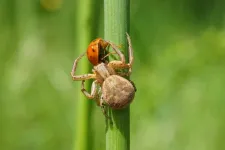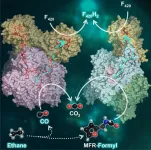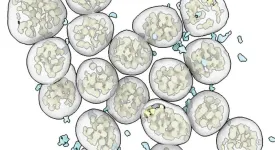(Press-News.org) Woods Hole, Mass. – Coral reefs worldwide are in trouble. These ecosystems support a billion people and more than a quarter of marine species. Still, many have been damaged by unsustainable fishing and tourism, coastal construction, nutrient runoff, and climate change. Now, researchers have shown that broadcasting the sounds of healthy reefs is a way to encourage larval corals to repopulate degraded sites and help revitalize them.
A recent study done by researchers at the Woods Hole Oceanographic Institution (WHOI) showed that golfball coral larvae can be encouraged to settle when they hear the sounds of a vibrant, healthy reef. This is the second coral species to demonstrate a responsiveness to sound, indicating that this technique has the potential to be a widely applicable tool for reef restoration.
“Acoustic enrichment is continuing to show promise as a technique in the field and in the lab to enhance coral settlement rates,” said Nadège Aoki, a doctoral candidate at WHOI and first author of the recently published paper in JASA Express Letters. “There is a very limited pool of species that have had any kind of acoustic work done with them so far, and this is the second one where the corals have responded to replayed sound and settled.”
During the larval stage of their life, corals drift or swim through the water looking for the right place to settle. To decide where they should attach to the seabed and mature into their stationary adult forms, coral larvae may rely on cues from chemicals, light, and – as Aoki and her colleagues demonstrated previously and in this study – sounds. Healthy coral reefs echo with a chorus of purrs and grunts from fish feeding, looking for mates, or defending their territories, underscored by the persistent crackling of snapping shrimp. Damaged or degraded reefs are much quieter, and it appears that some coral larvae can tell the difference.
In July of 2022, Aoki and her colleagues collected larvae from Favia fragum – commonly known as golfball coral – in the U.S. Virgin Islands. They divided the larvae into cups and set them up in two quiet, sandy bays off the southeastern coast of St. John: Great Lameshur Bay and Grootpan Bay. At Great Lameshur, the researchers placed the cups of larvae one meter away from a solar-powered speaker playing sounds recorded at the nearby Tektite reef, which is considered relatively healthy and noisy. The researchers used the same setup in Grootpan Bay, but the speakers only played silence or sounds recorded in Grootpan.
At each site, half of the larvae cups were in the water for 24 hours and half for 48 hours. After 24 hours, none of the larvae at the control site had settled to the bottom of their cups, but about 30% of the larvae hearing the sounds of a healthy reef had settled. After 48 hours, the settlement rates at both sites were much higher and roughly equivalent – around 73% at Great Lameshur and 85% at Grootpan.
The sample sizes at both time intervals were too small for the results to be statistically significant. However, the researchers also conducted a similar experiment in fiberglass aquarium tanks. In the tanks, they checked for larval settlement after 24 and 72 hours of sound exposure. Combining these results, they found that golfball coral larvae settled at significantly higher rates when exposed to the sounds of a healthy reef during their first 36 hours. After that window, the larvae settled at basically the same rate, regardless of what they were hearing.
“Acoustic enrichment worked for 36 hours or so,” said Aran Mooney, a marine biologist at WHOI and senior author of the paper. “After that, they seem desperate to settle, and healthy cues become less important.”
Golfball coral have a relatively short window of viability in their larval stage. They don’t have the resources to float around for weeks searching for the ideal spot; they want to settle in 8 to 36 hours after they are released into the water, Mooney said. The researchers found that sound cues are most effective while the larvae have the resources to be picky – once they run out of time, they’ll settle just about anywhere.
“We’re getting at some of the nuances of coral biology,” Aoki said. “There’s a huge range of reproductive strategies that corals use and different species have different larval periods. We’re opening up this broad realm of questions about how responsiveness to sound will vary between species.”
The work also demonstrates that corals will respond to auditory cues even in tanks, where sound reflections, aerators, and water filters make the acoustics less than ideal. It can be tricky to get corals to reproduce and settle in tanks, sometimes taking months to get everything just right. Adding healthy reef sounds might facilitate that process in land-based nurseries. There isn’t likely to be a single solution that works for every coral species in every part of the world, but the researchers hope that acoustic enrichment, applied with an understanding of the local ecology and coral biology, will prove to be an effective tool for coral restoration.
“Finding a second species settling in response to sound shows that this isn’t just a one-off, and maybe we can really scale this up,” Mooney said. “But we can’t just throw a speaker over the side of a boat and think it’s going to work. We have to know the system and it has to be integrated with other conservation and restoration efforts.”
This research was supported by the Vere and Oceankind Foundations, the National Science Foundation, and WHOI’s Reef Solutions Initiative.
###
About Woods Hole Oceanographic Institution
Woods Hole Oceanographic Institution (WHOI) is a private, non-profit organization on Cape Cod, Massachusetts, dedicated to marine research, engineering, and higher education. Established in 1930, its mission is to understand the ocean and its interactions with the Earth as a whole, and to communicate an understanding of the ocean’s role in the changing global environment. WHOI’s pioneering discoveries stem from an ideal combination of science and engineering—one that has made it one of the most trusted and technically advanced leaders in fundamental and applied ocean research and exploration anywhere. WHOI is known for its multidisciplinary approach, superior ship operations, and unparalleled deep-sea robotics capabilities. We play a leading role in ocean observation and operate the most extensive suite of ocean data-gathering platforms in the world. Top scientists, engineers, and students collaborate on more than 800 concurrent projects worldwide—both above and below the waves—pushing the boundaries of knowledge to inform people and policies for a healthier planet. Learn more at whoi.edu.
END
An international research team led by NYU Tandon School of Engineering and KAIST (Korea Advanced Institute of Science and Technology) has pioneered a new technique to identify and characterize atomic-scale defects in hexagonal boron nitride (hBN), a two-dimensional (2D) material often dubbed "white graphene" for its remarkable properties.
This advance could accelerate the development of next-generation electronics and quantum technologies.
The team reported that it was able to detect the presence of individual carbon atoms replacing boron atoms in hBN crystals. This discovery was made possible by listening to ...
Animals not only need sufficient calories to function, but also essential nutrients — including omega-3 and omega-6 polyunsaturated fatty acids (PUFA). Insects and arachnids are an important source of these essential fatty acids for birds, hedgehogs, lizards and the like. However, the content depends on the specific types of insects and spiders consumed. Aquatic insects, such as caddisflies or dragonflies, contain significantly more omega-3 long-chain (LC) PUFA than terrestrial insects because omega-3- LC-PUFA rich algae form the base of the food chain in aquatic ecosystems.
The ...
PHILADELPHIA — Donald E. Arnold, M.D., FACHE, FASA, chair of the Department of Anesthesiology, Mercy Hospital in St. Louis and member of the board of directors of Western Anesthesiology Associates, Inc., in Ballwin, Missouri, was today named president of the American Society of Anesthesiologists (ASA), the nation’s largest organization of anesthesiologists. Dr. Arnold assumed office at the ANESTHESIOLOGY® 2024 annual meeting and will serve for one year.
“I’m honored to be named president of ASA and committed to serving our members, supporting the Society’s mission to advance the specialty, preserving physician-led anesthesia care, and above ...
Wealth is one of the strongest indicators of social status, acting as a key indicator of social inequality and influencing access to education, health care and professional success. In a study, researchers from the Max Planck Institute for Demographic Research, the University of Cologne, GESIS and the Norwegian Institute of Public Health examined how financial wealth changes related to various generational transitions within families. The study used data from Norwegian registries and focused on people born in 1953.
Investigating changes in wealth within the ...
Seeps on the deep seafloor naturally emit alkanes, which are pollutants that are potentially dangerous to life and act on global warming. Fortunately, the sediments around the seeps host microbes that act as a biological filter: They consume most of the alkanes before their release into the oceans and our atmosphere. This so-called anaerobic oxidation of alkanes is an important yet poorly understood microbial process. Scientists from the Max Planck Institute for Marine Microbiology in Bremen, Germany, now ...
The National Institutes of Health (NIH) has launched a proof-of-concept precision medicine clinical trial to test new treatment combinations targeting specific genetic changes in the cancer cells of people with acute myeloid leukemia (AML) and myelodysplastic syndromes (MDS). The trial, funded by NIH’s National Cancer Institute (NCI), aims to accelerate the discovery of more tailored treatments for these aggressive cancers of the blood and bone marrow.
“AML and MDS are a heterogeneous group of cancers that can progress very quickly. Treatment advances depend in part on the ability to rapidly identify which subtype of cancer each patient has so that treatments can be tested for ...
New York, NY, October 23, 2024 — Scientists at the Icahn School of Medicine at Mount Sinai, in collaboration with colleagues in the field, have developed an innovative antibody platform aimed at tackling one of the greatest challenges in treating rapidly evolving viruses like SARS-CoV-2: their ability to mutate and evade existing vaccines and therapies.
Their findings, including preclinical studies in mice, introduce the Adaptive Multi-Epitope Targeting and Avidity-Enhanced (AMETA) Nanobody Platform, a new antibody approach for addressing how viruses like SARS-CoV-2, which causes COVID-19, evolve to evade vaccines and treatments. Details on the results were published October 23 ...
Four leading cancer research organizations in the United States and Canada announce the opening of patient enrollment to myeloMATCH, a unique portfolio of clinical trials to test precision medicine treatments for adults with acute myeloid leukemia (AML) or myelodysplastic syndrome (MDS).
The Alliance for Clinical Trials in Oncology, Canadian Cancer Trials Group, ECOG-ACRIN Cancer Research Group, and SWOG Cancer Research Network are collaborating within the National Cancer Institute (NCI) National Clinical Trials Network (NCTN) to design and lead the trials. They expect to open ...
About The Study: In this cross-sectional study of 14,000 insured adults, individual-level social determinants of health were significantly associated with U.S. health care expenditures by Medicare, Medicaid, and private insurers. These findings may inform health insurers and policymakers to incorporate social determinants of health in their decision-making practices to identify and control health care expenditures, advancing health equity.
Corresponding Author: To contact the corresponding author, Giridhar Mohan, MPH, email gmohan1@jhu.edu.
To access the embargoed study: Visit our For The Media website at this link https://media.jamanetwork.com/
(doi:10.1001/jamanetworkopen.2024.40467)
Editor’s ...
About The Study: In this cohort study, distinct forms of traumatic and adverse childhood experiences differentially moderated developmental changes in psychiatric risk and cognitive ability in different ways, offering the possibility for precision-based prediction of risk for youth. Such findings could be used in targeted early prevention and intervention strategies for at-risk youth.
Corresponding Author: To contact the corresponding author, Justin D. Russell, PhD, email jdrussell3@wisc.edu
To access the embargoed study: Visit our For The Media website at this link https://media.jamanetwork.com/
(10.1001/jamapsychiatry.2024.3231)
Editor’s ...




